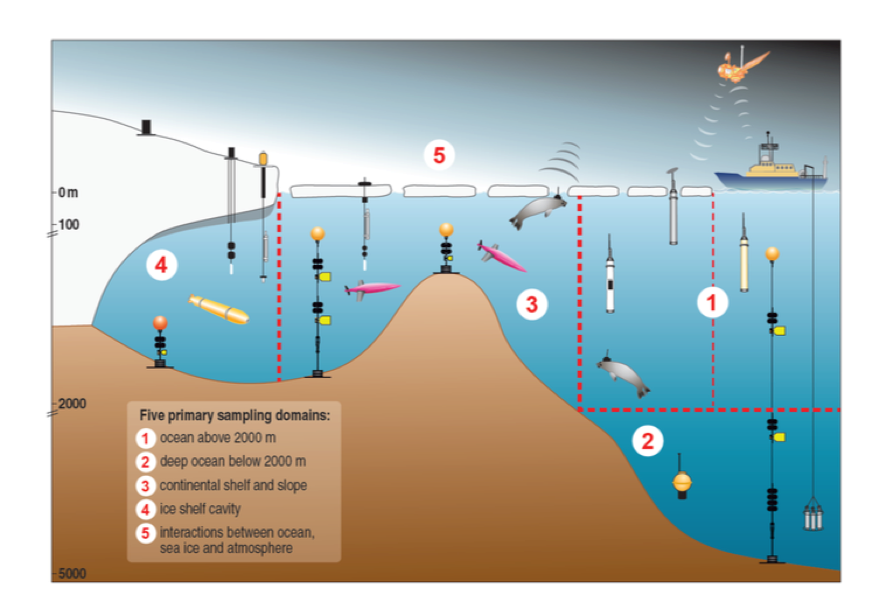Observing and Understanding the Ocean below Antarctic Sea Ice and Ice Shelves (OASIIS)

This Capability Working Group is now complete.
The working group held a very successful workshop in 2017, made a significant contribution to the community OceanObs paper “Delivering Sustained, Coordinated, and Integrated Observations of the Southern Ocean for Global Impact”, and in 2020 released a factsheet on ocean observations beneath ice.
Understanding the interactions between the Southern Ocean, atmosphere and cryosphere is fundamental to our understanding of global climate, biogeochemical cycles, biological productivity and sea-level rise. Despite this global imperative, the ocean beneath the Antarctic sea ice and ice shelves remains one of the least observed physical systems on the planet. This has limited our progress in understanding air-ice-ocean interactions and their sensitivity to climate change. The only way to fill this gap - the largest "blind spot" in the global ocean observing system - is an internationally coordinated, integrated and circumpolar under-ice observing system in the Southern Ocean.
A "truly global" ocean observing system must include observations of the ocean beneath Antarctic sea ice and ice shelves as these are of critical importance to understanding the impacts of climate change on society. For example, the greatest uncertainty in future sea-level rise is the contribution from the Greenland and Antarctic Ice Sheets. We now know that the fate of the Antarctic Ice Sheet is directly coupled to changes in the surrounding ocean. The Southern Ocean takes up vast amounts of anthropogenic heat and carbon dioxide, helping to slow the rate of climate change, but the future of the Southern Ocean sinks are uncertain. Changes in Southern Ocean sea ice, circulation and chemistry (e.g. acidification) will affect Southern Ocean ecosystems and fisheries and alter nutrient transports with impacts on global productivity. There is increasing demand for short-term ocean forecasts and seasonal predictions that depend on assimilation of observations from the high latitude oceans. Effective policy to mitigate and adapt to climate change requires knowledge of how the ocean-ice-atmosphere system will respond to a warming climate. Sustained observations of the Southern Ocean, including the ocean beneath sea-ice and ice shelves are critical to anticipate and respond effectively to these societal challenges.
OASIIS working group contributes to the SOOS Science Priority Theme 3, “the role of the ocean in the stability of the Antarctic Ice Sheet and its future contribution to sea-level rise” . SOOS facilitated the development of this working group within Partnership for Observation of Global Oceans (POGO). The core goal of OASIIS is to develop a detailed implementation plan for an under-ice observing system, including definition of quantitative sampling requirements and identification of leaders (teams) to take implementation of key elements of the observing system forward. For detailed information on what this working group will do, download the POGO proposal here. This working group was approved in 2016 and is proposed to finish in 2018.
Loading Products
Loading Events

Objectives
The goal of the working group is to develop a detailed implementation plan for an under-ice observing system, including definition of quantitative sampling requirements and identification of leaders (teams) to take implementation of key elements of the observing system forward.
This working group will build on the success of the 2012 SOOS workshop that articulated the scientific rationale and justification for an under-ice observing system in the Southern Ocean in the report “Seeing Below the Ice: A strategy for observing the ocean beneath Antarctic sea and ice shelves”. This included a strawman proposal for an under-ice observing system but lacked a detailed implementation plan. The absence of a clearly articulated implementation plan, with quantitative design requirements, is stalling efforts to establish an internationally coordinated under-ice observing system.
The next step forward (and the goal for this working group) is to prepare a detailed community-led implementation plan for this integrated, circumpolar Antarctic under-ice observing system. The goals of this working group are directly tied to POGO’s core mission statement to lead the innovation and development of crucial components of the ocean observing system. Articulating a strong case to the community for an under-ice observing system with clear steps as to how this might be realized, and the societal benefits, will enable POGO members/national programs to approach funders with a clear rationale and justification for funding field campaigns, observational infrastructure and technology and capability development.
Over the past decade, technological advancements in ocean observing mean we now have the capability to observe beneath the Antarctic sea-ice and ice shelves. Many key platforms such as Argo floats, ice-tethered profilers, gliders, instrumented-seals, moorings, passive and active acoustics, satellites, etc. have proven successful in returning data from these harsh environments and are deployment-ready now. The working group will outline how we can effectively use existing platforms to form the backbone of an under-ice observing system as well as identifying important new technologies/sensors and how to advance them. Rapid development of technology into the future will allow us to expand upon this core capability and enhance under-ice observations even further.
A key part of building an under-ice observing system is to articulate what we can do now with existing platforms and technology, and to identify areas for future technological development and innovation (a key priority for POGO). The working group anticipates developing close links with engineers and manufacturers who are progressing efforts to make their platforms/sensors under-ice capable and provide opportunities for them to collaborate with scientists on field-campaigns to test equipment in-situ and help drive the technology forward.
The working group will speed progress by identifying and commissioning specific discussion papers before the workshop. Topics might include, but are not limited to;
-
What is the optimal and feasible strategy for deployment of acoustically and non-acoustically tracked floats?
-
How can we combine under-ice (e.g. AUV), through-ice (e.g. boreholes) and on-ice (e.g. radar) measurements to observe the ocean and bathymetry beneath ice shelves?
-
What is the right mix of platforms to observe under-ice ecosystems?
-
How do we best integrate observations and modelling efforts?
-
What are robust means to enable navigation and data telemetry with autonomous platforms (eg. floats, glides, AUVs) under ice?
-
What is the status of biological and biogeochemical sensors appropriate for deployment on autonomous vehicles in the sea ice zone?
-
What products can an under-ice observing system deliver that are of value to users?
-
What regions are particularly suitable for pilot deployments of an integrated under-ice observing system?
-
How do we allocate resources between broad-scale sampling and focused regional or process studies?
-
What is the status of key technologies in terms of readiness and relevance for an integrated under-ice observing system (e.g. floats, gliders, ice-tethered platforms, acoustic navigation, biogeochemical sensors, expendable moorings, AUVs and UAVs)
-
What role can sensor networks play in providing a coherent picture of physics, chemistry and biology on time-scales from months to decades?
Planned Products and Outcomes
Leadership
Contributing Modelling and Field Activities






